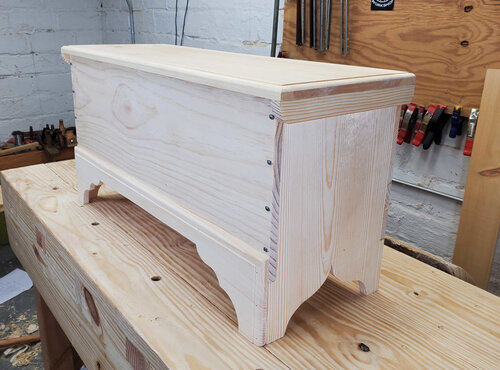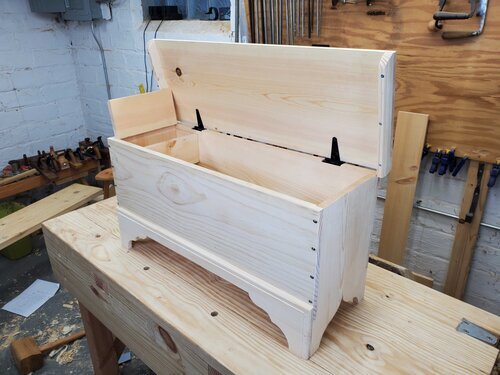Fabrication First: Two Kinds of Beauty
February 1st, 2021
Two Kinds of Beauty
I just finished an Early American blanket chest. It’s got crisp lines and smooth curves. And right on the lid is a spot of tear-out the size of a plum. You can’t miss it. The grain reversed and my smoothing plane just savaged the surface.
I’ve got a lot of options. I could scrape it, or sand it, or even re-plane the whole lid and cut the moldings all over again. But I’m not going to do any of those things.
I’m just going to leave it.
Most woodworkers would never leave such an obvious flaw in their work. They would go to any length to make every surface perfect. I understand. I used to be one of these people, but my obsession with perfect surfaces went out the window around the same time I stopped buffing my polyurethane to a mirror-shine. Details like that just don’t matter to me anymore.
Some people might accuse me of sloppiness in my work, but I think my changing attitude is just me maturing into my craft. You know who’s really obsessed with surfaces? Beginners.
The surface of the work is the most accessible because it’s right out front. Surfaces are also easy to understand. Smooth is smooth. Shiny is pretty. Swirly, exotic grains are also pretty. Everyone knows this.
Surface is the first kind of beauty. That’s what you see up close when your eyeball is inches from the work or your fingers are trailing along the top. Surface is a completely legitimate thing to care about, but there’s a second kind of beauty that matters more to me. The second kind of beauty is form, structure, and context. This kind of beauty is more abstract and more difficult to achieve.
Every artform is like this. The beginner is obsessed with surface. I play the guitar and like every young guitarist, I used to be very impressed by speed. More notes meant higher technical proficiency, which was automatically better. Unless you’ve ever heard John Lee Hooker. Then speed seems pretty irrelevant. There are bigger things to worry about, like songs.
If a piece of furniture is like a song, then the twisty grain of the imported wood and the high-gloss finish are the guitar solo; fine by itself, but no substitute for good songwriting.
So what do I care about? Mostly shape, proportion, and the way a piece fits into the room. Nobody wants a saxophone solo in a folk song and I don’t want a William and Mary veneered chest in my 1920s house. The rooms in my home look better with simpler styles: Early American, Craftsman, and Shaker. The other stuff might be fun to build, but it would be terrible to live with, so I’m not going to build it.
I paint a lot of my pieces. This horrifies many craftspeople. “Aren’t you going to varnish it? What about a French polish?” They want to know why I would bury the wood grain under a clumsy, opaque layer of…color. Isn’t that just wrong?
I don’t think so. I quite like colors in my home. Unsurprisingly, they brighten things up. I like walnut burl grain as much as the next fellow, but too much wood makes a room feel dark and oppressive. Our obsession with clear finishes and dramatic wood grain is also kind of a modern affectation. Furniture of past centuries was often painted in bright, festive colors and designs that look wild even to the modern eye. You don’t find these pieces in the homes of wealthy aristocrats, but it turns out that average people actually enjoyed color in their homes. They liked things to be bright. They liked fun.
I like fun, too.
It’s one of my highest priorities in my work. I want to have fun while I’m building furniture and I want my pieces to create a cheery and bright environment for my family. So I try for pieces that work well and bring a little energy into my life. I like a straight line, a crisp molding, and a fair curve, but I also try to make work that brings vigor into my home. That’s fun.
Here’s what’s not fun: slaving away to plane a smooth finish on some wild species that’s brittle as glass. I also don’t enjoy the ultra-hard exotics that many people pay big money for. I think that I will never build a piece of furniture out of purpleheart. I prefer oak. I honestly do.
As a craftsperson, you are free to care about whatever matters to you. I’ll never criticize you if you want to make a dining chair out of lacewood. But if you see a chip or a ding in one of my pieces, you don’t need to tell me about it. If I built the thing, I know what’s there. I just don’t happen to care.
What I care about is building a piece that sits in the room like it was always there. I want the viewer to think my work is so right for the space that it might have grown out of the floor, as natural as a tree in the forest.
That’s the kind of beauty I’m after.
(The video on the blanket chest will be out Wednesday at 2:30 PM. Patrons got early access on Saturday. Sign up for Patreon and get early access to all my videos, exclusive content, all my plans for FREE, and access to the best woodwork discussion forum on the Web.)




